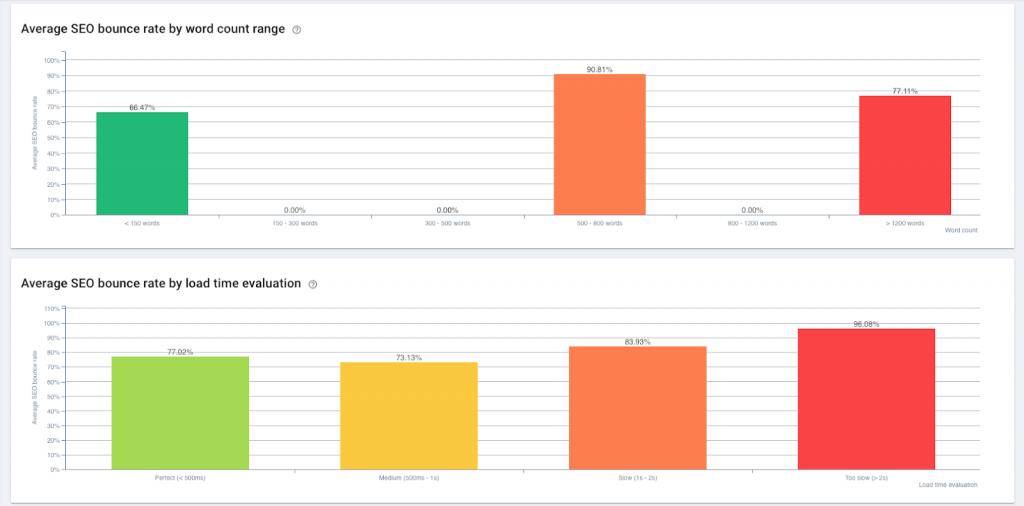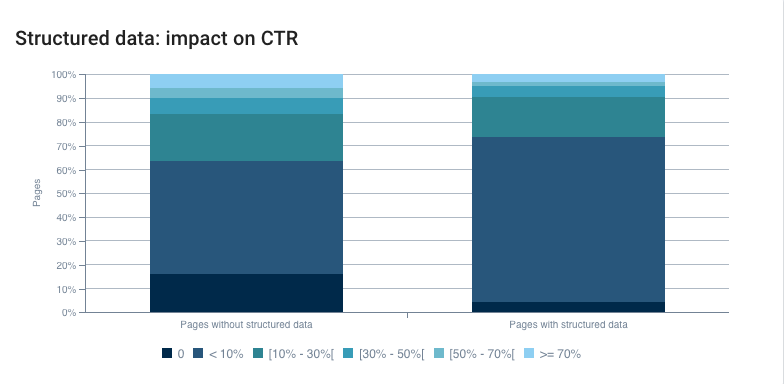When it comes to reporting on your marketing performance, there are a lot of indicators to track. And SEO is one of the channels that has a direct impact on your brand visibility. Analyzing your SEO performance can give you valuable and fast answers to your marketing questions.
As a CMO, you can ask yourself: what are the key performance indicators and results that need to be monitored to set up actionable reporting and ensure the sustainability of an SEO program?
Marketers and SEOs must work with other individuals in all sorts of job roles – executives, tech staff, content specialists, and many more – to answer and address questions such as:
- Do you have precise SEO metrics and KPIs? And have you improved over time?
- Is your tracking and reporting in place?
- How will you measure success?
- Have you set realistic goals for timelines of success?
1. Organic traffic & crawl frequency
While organic traffic is a very basic indicator, it’s definitely a not-to-miss! Using an analytics solution, you’ll be able to see an increase or decrease in quality web traffic and user experience that build the brand and drive revenues. One of the most popular methods to track organic traffic is to use Google Analytics. It’s an efficient tool to measure sessions and the time users spend on your website. An increase in sessions over several months generally means that your SEO optimizations have been working or that seasonal trends in your business are in play.
An interesting thing to do is to compare different periods to see what SEO-centric changes have been made and could have contributed to traffic growth.
With Oncrawl, you can go further and map your website by groups of pages. For instance, for an ecommerce website, you could have different groups for each type of products or groups by types of goals (or both). It is interesting to know that your traffic has increased–but is it on your strategic pages? If you have seasonality spikes for Christmas, for instance, you need to be sure that the right pages are being seen by your visitors at that time of the year.

Distribution of active pages by groups over time
In the example above, page groups have been set for each type of product. The most surprising thing is that the vast majority of pages in these groups are not generating any SEO traffic from search engines. This represents a loss in terms of visibility and potential conversions. You can ask yourself: why are these pages not active? Look at these pages from a different angle:
- Is the page fast enough?
- How is content quality?
- Is there any 4xx or 5xx errors?
- How is link juice distributed?
- Are they blocked with a robots.txt?
- And so on…
2. Mobile traffic & mobile-first index
Looking at your mobile traffic is a valuable indicator for any CMO. Understanding how users are consuming your content is important if you want to deliver the best user experience. Having a mobile-friendly version of your website is then crucial if most of your traffic comes from mobile search results.
People are spending more and more time on their mobile devices and tablets, yet many websites still are not designed to support different screen sizes and load times. Optimize your site design, architecture, and speed to ensure you’re not turning visitors – and potential customers – away.
And starting last July 1, all new sites are indexed using Google’s mobile-first indexing. You’ll need to look at how your bots hits are distributed between desktop and mobile.

Distribution of desktop vs mobile bots hits over time
Google has shared a couple of recommendations regarding this new way to index websites. If you don’t have a mobile version of your website, the search engine will keep crawling your desktop version. However, if you do have a mobile version, be sure its contents and links are similar to your desktop version so that Google continues to rank your site as it did with your desktop version.
Content on both version needs to remain the same if you want Google to index your mobile content. If you need to organize your content on the mobile version, Gary Illyes stated that expandable content like tabs, boxes or accordions could be a valuable solution for user experience and using them won’t be regarded as having less content on a page.
In fact, a responsive approach seems to be the easiest way to keep the same amount of content on a page-by-page basis between desktop and mobile.
Also make sure the Google mobile bot doesn’t retrieve any status code errors when crawling your website.

Repartition of status codes errors by pages over time
3. Conversion rate
Conversion rate is another indicator that matters for CMOs. When you think about conversion rate, you need to think about the big picture: Drive, Capture, Convert and Optimize. When it comes to the Drive step, SEO plays a big part as marketers need to drive traffic to a company’s website. Search engine optimization is an efficient source of traffic if well executed.
Visibility and findability
To understand if your website is findable on search engines, look at your landing pages and how users behave. Google Analytics provides basic metrics regarding:
- Sessions
- Users
- New Users
- Bounce rate
- Pages/session
- Avg. Session Duration
If you want to add a layer of analysis, you can use a solution like Oncrawl Analytics to analyze:
- Bounce rate from search engines
- SEO page in 4xx errors
- Average SEO bounce rate by word count range
- Average SEO bounce rate by load time evaluation

Average bounce rate from organic results by word count and load time
Combined with a full crawl, this will tell you how ranking factors – such as your content quality, architecture, page performance and HTML tags – influence your SEO traffic.
You’ll be able to answer these questions:
- Is a landing page driving a lot of traffic but has a high bounce rate? This could suggest users aren’t finding what they’re looking for.
- Does a landing page have a strong pages/session but no associated conversions? This could suggest users are exploring but aren’t engaging with your site.
Structured data & click-through rate
It’s no secret that adding structured data to your content when it’s relevant can help you increase your CTR in search results.
For instance, if you list the best hotels in Paris, you should make sure your hotel is in the list! If you are an aggregator (like Booking.com), you could add an extra value layer, such as live pricing. This way, the user will have to move through to your site to be able to complete their transaction.
Another technique is to add too many structured data items so that Google can’t display them in full.
Using Oncrawl, you can look at how structured data are impacting your CTR.

In other words, when measuring your marketing performance, you should include SEO metrics in your dashboards. We talked specifically about organic traffic, conversion rate and mobile traffic, but there are tons of other SEO-related indicators that can influence your global marketing performance. Be sure to track the right indicators with efficient analytics and SEO tools. Data is key to understanding what’s really going on with your website and where you should start taking action.

